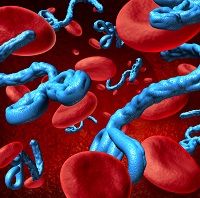Article
New Ebola Test Gives Current Gold Standard a Run for Its Money
Author(s):
In just 15 minutes an Ebola fingerstick blood test can accurately determine whether a patient is infected with the virus, a team from the Viral Hemorrhagic Fever Consortium reported.

In just 15 minutes an Ebola fingerstick blood test can accurately determine whether a patient is infected with the virus, a team from the Viral Hemorrhagic Fever Consortium reported.
The diagnostic test requires a few drops of blood and works similarly to an at-home pregnancy test. The ReEBOV Antigen Rapid Test Kit (RT-PCR) is the first and only of its kind to receive approval from the World Health Organization (WHO).The Ebola assessment tool will be presented at the 2015 American Association for Clinical Chemistry (AACC) Annual Meeting & Clinical Lab Expo in Atlanta, GA.
“All three studies — our internal emergency use authorization study, the WHO study, and The Lancet paper — show that the rapid test can provide a plus 90% accuracy when paired with the PCR test,” Matt Boisen, of the Viral Hemorrhagic Fever Consortium who will present the test at AACC, said in a news release.
The study published in The Lancet tested 106 participants in Sierra Leone suspected to be infected with the Ebola virus. The rapid fingerstick blood test results were compared to the RealStar Filovirus Screen RT-PCR kit — the current gold standard Ebola test. Both methods successfully identified 28 patients infected with the disease. In addition, they verified 71 of the 77 uninfected individuals.
The analysis conducted by the WHO included 292 blood samples. The findings indicated that the ReBOV system concurred with the RT-PCR on 91.8% of infected and 84.6% of non-infected samples.
“This really establishes that the rapid test can be used as a triage method to quickly provide patient results that can later be confirmed by PCR,” Boisen confirmed.
Since ReEBOV provides sufficient results in a minimum amount of time, it can be used in combination with RT-PCR to make quick treatment decisions.
“This represents a breakthrough in the detection of Ebola for this and future Ebola virus outbreaks,” Boisen concluded.
























